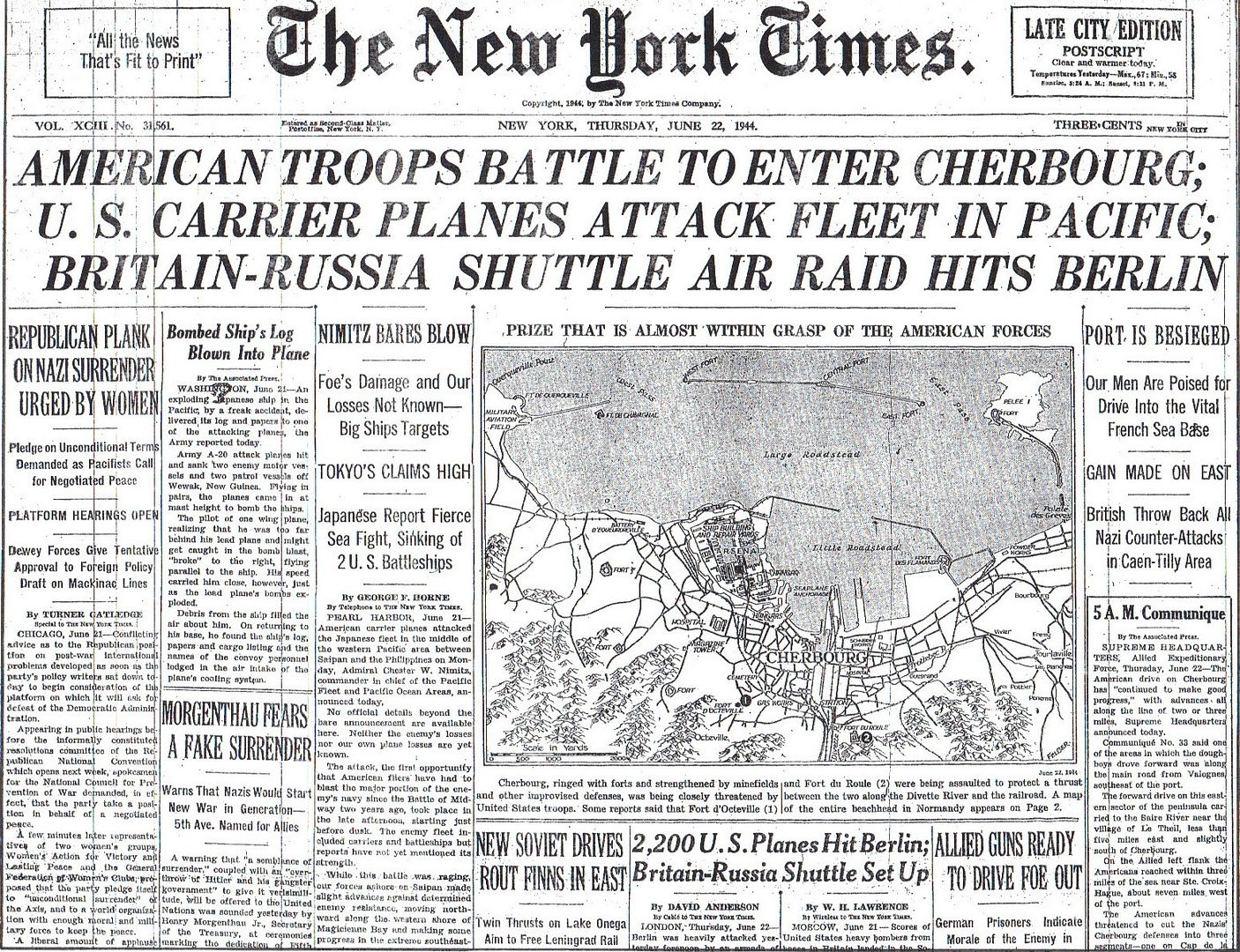
Posted on 06/22/2014 5:39:10 AM PDT by Homer_J_Simpson

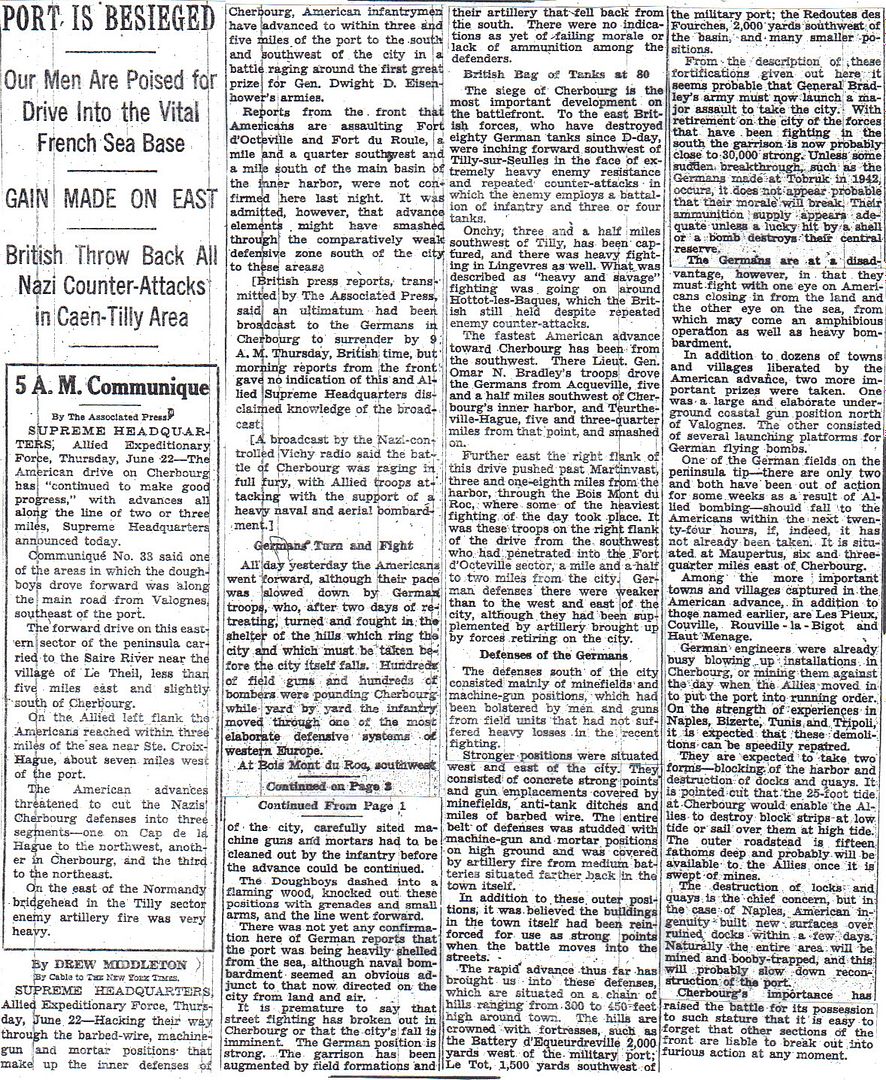
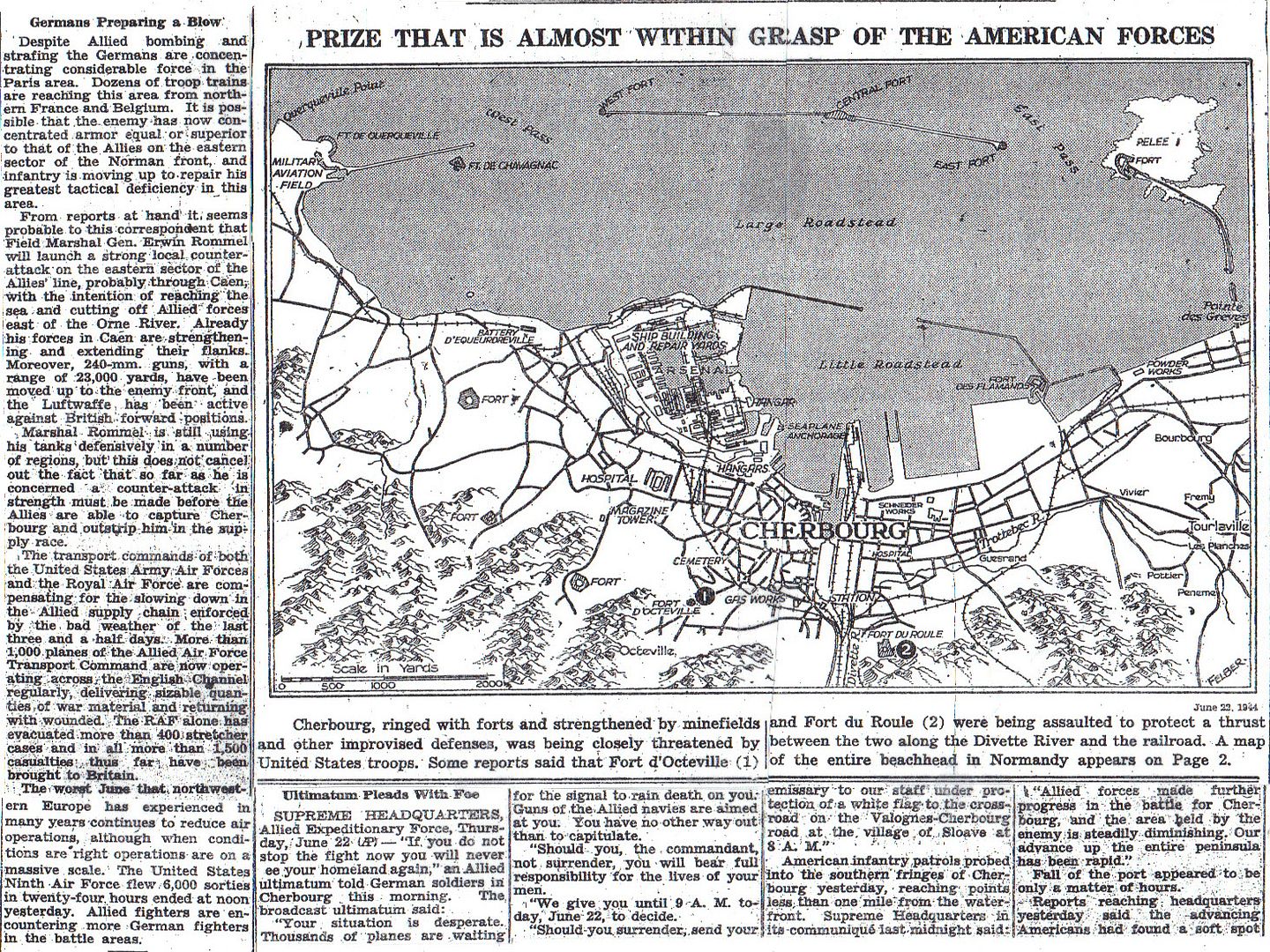
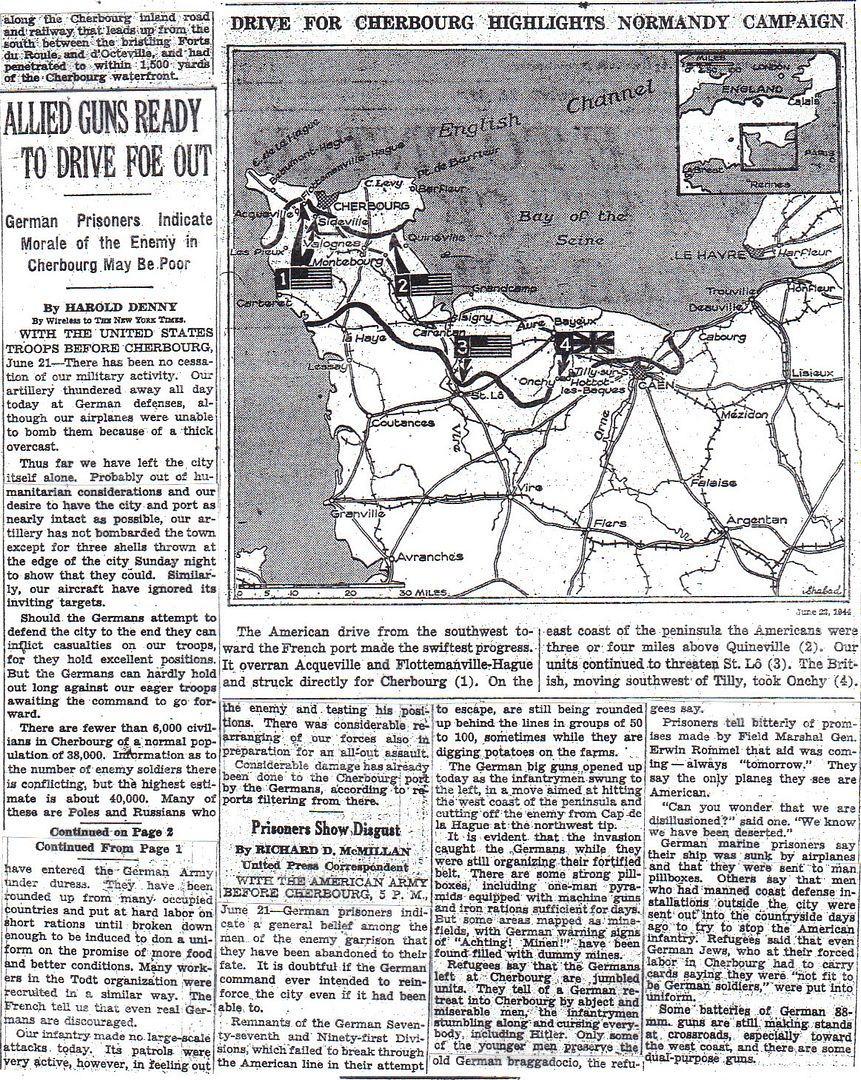

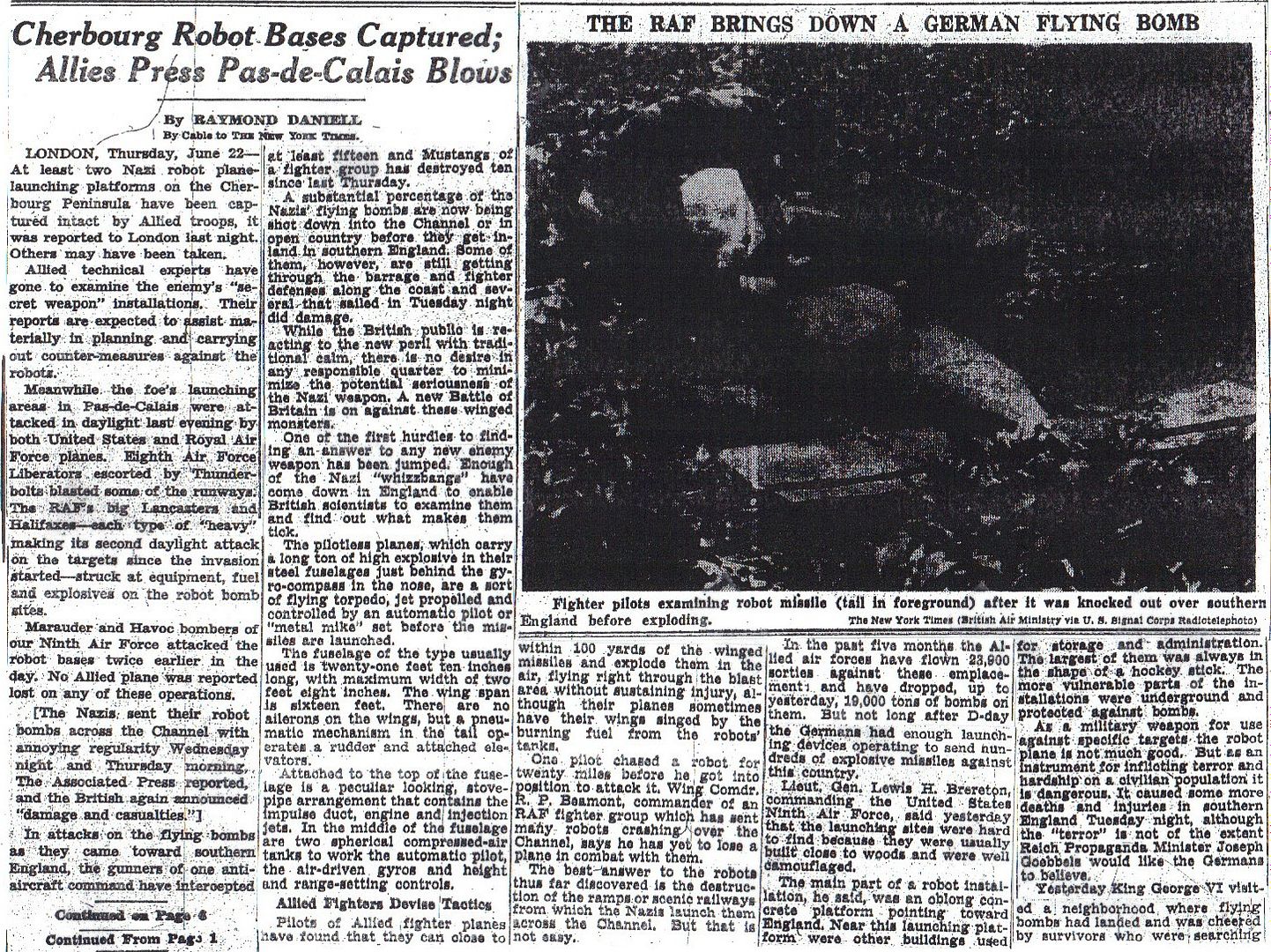

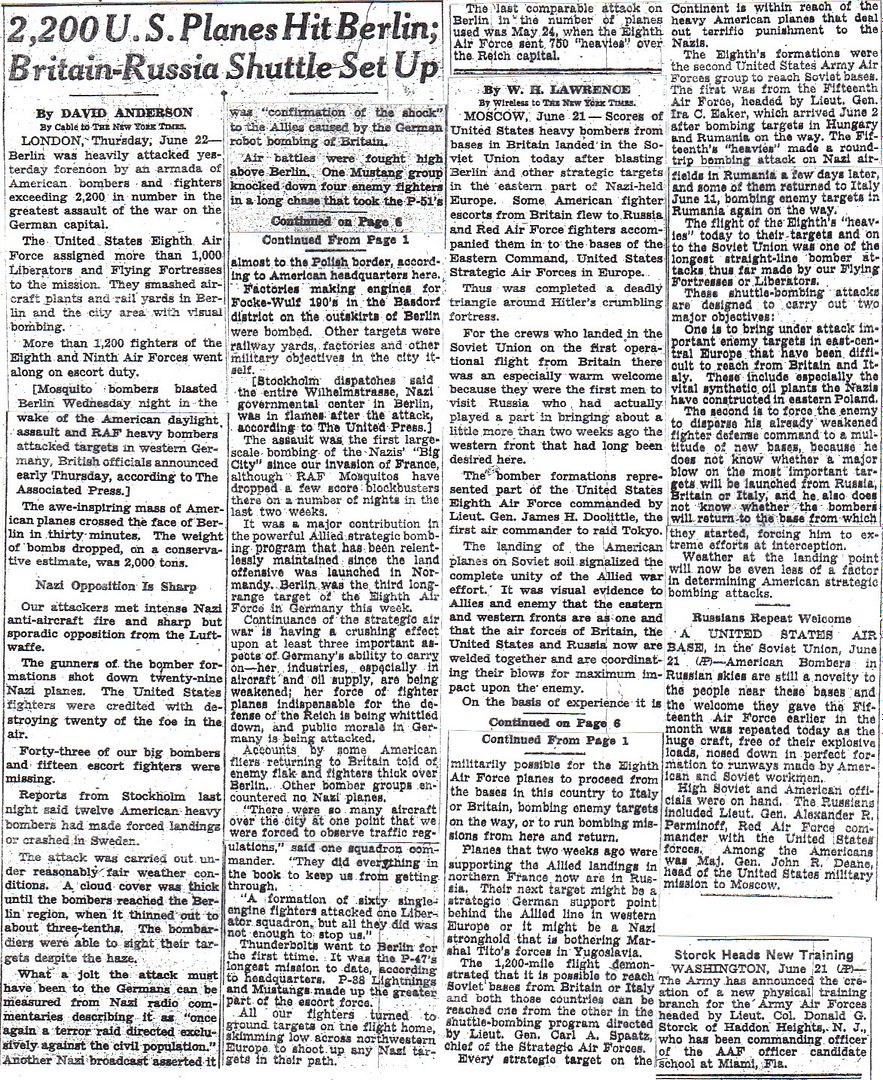
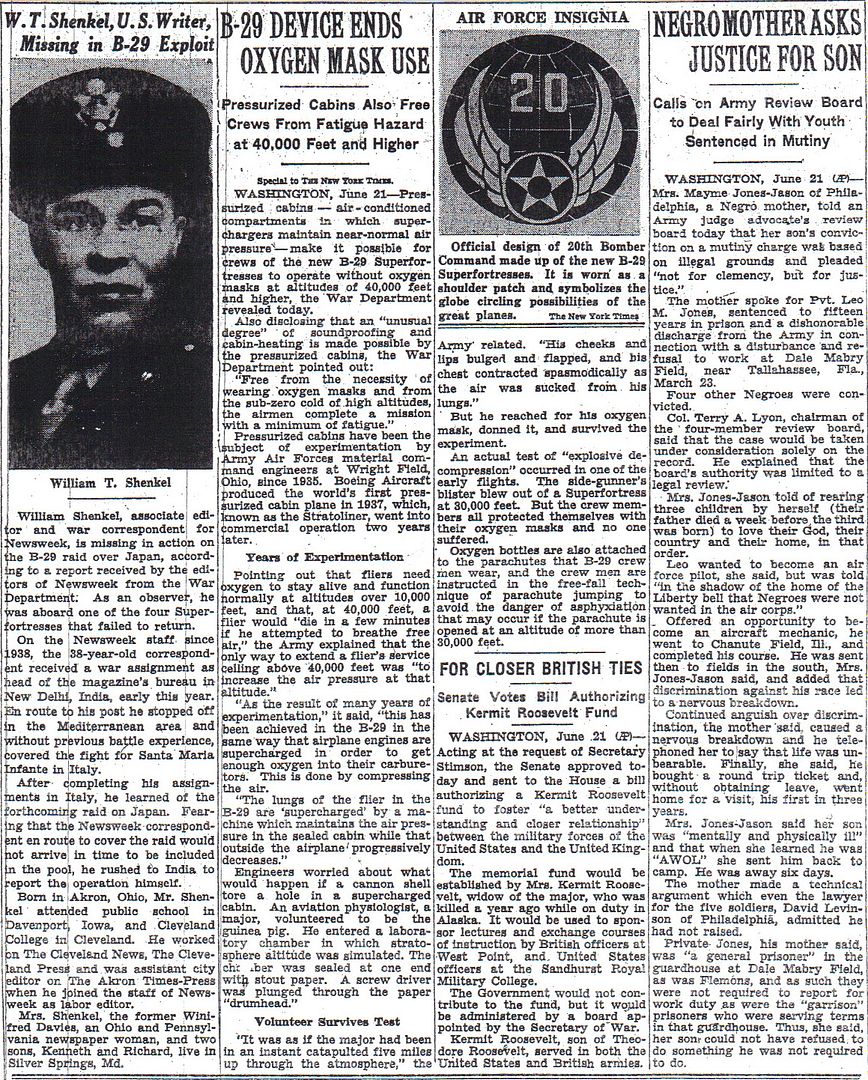
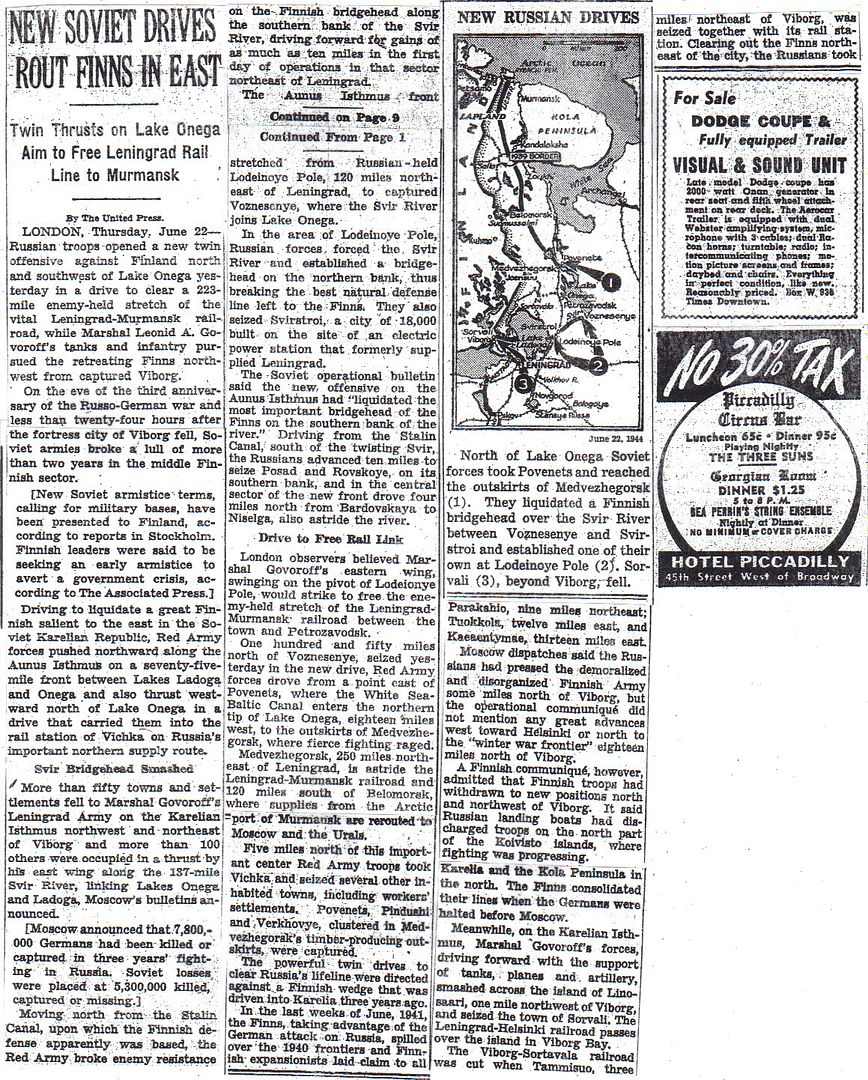
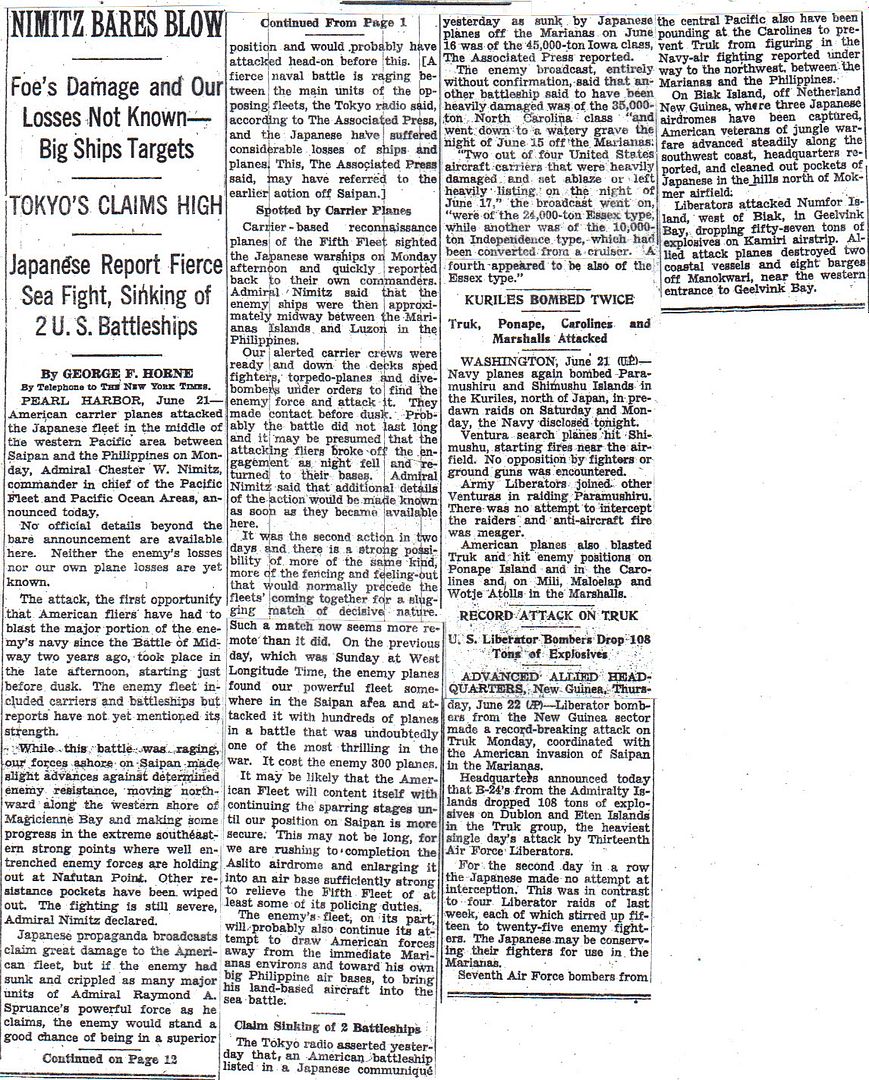
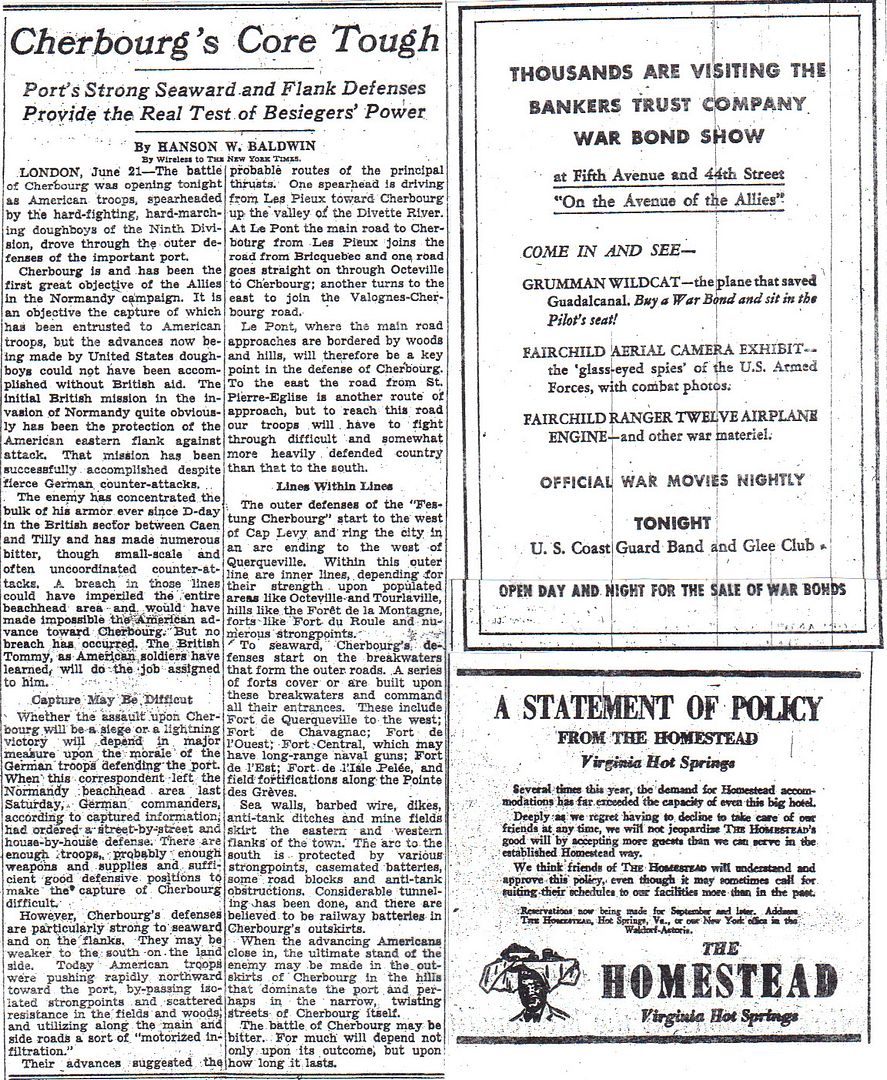
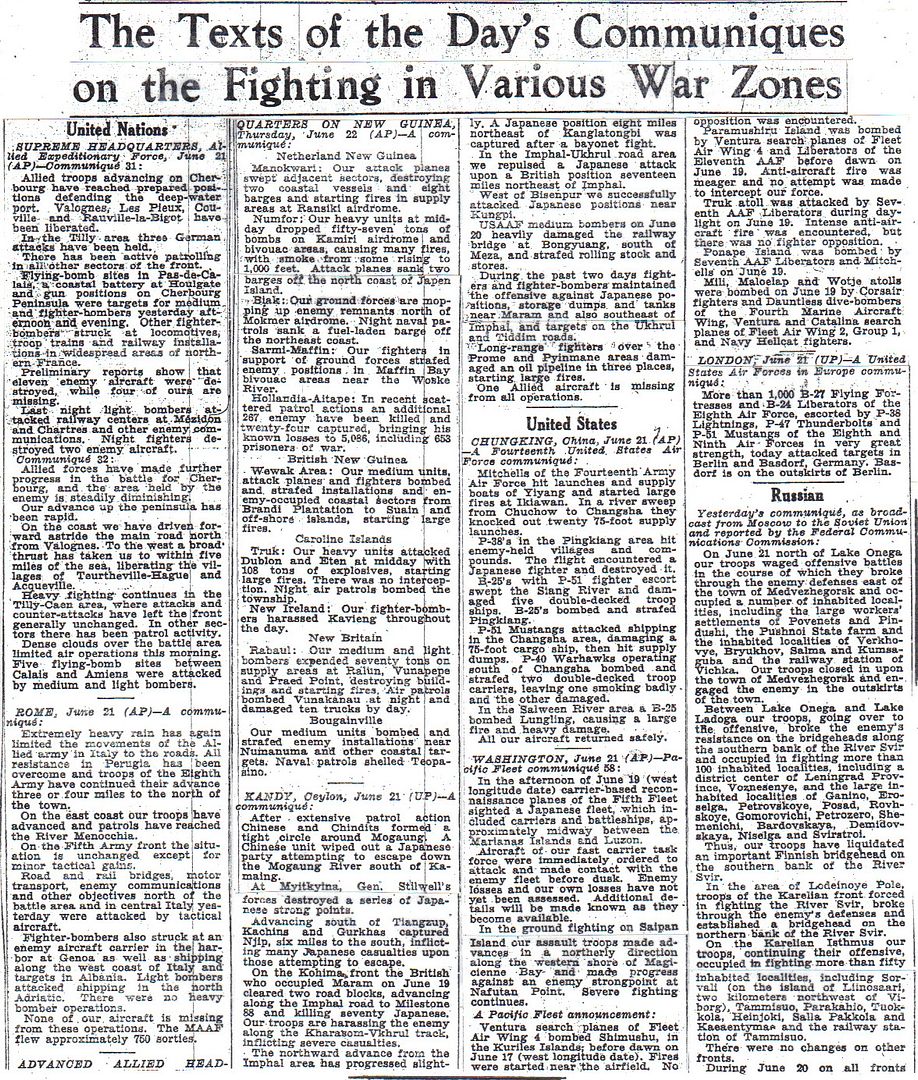
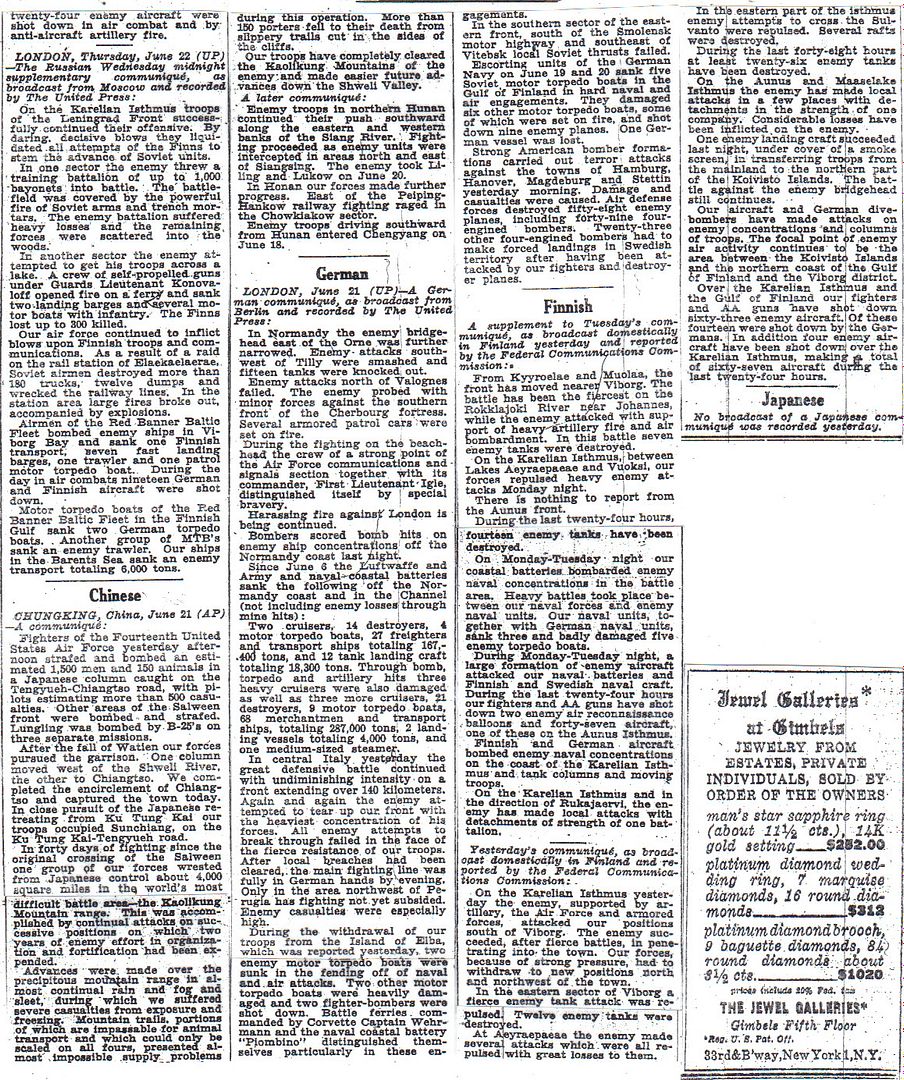

Winston S. Churchill, Closing the Ring
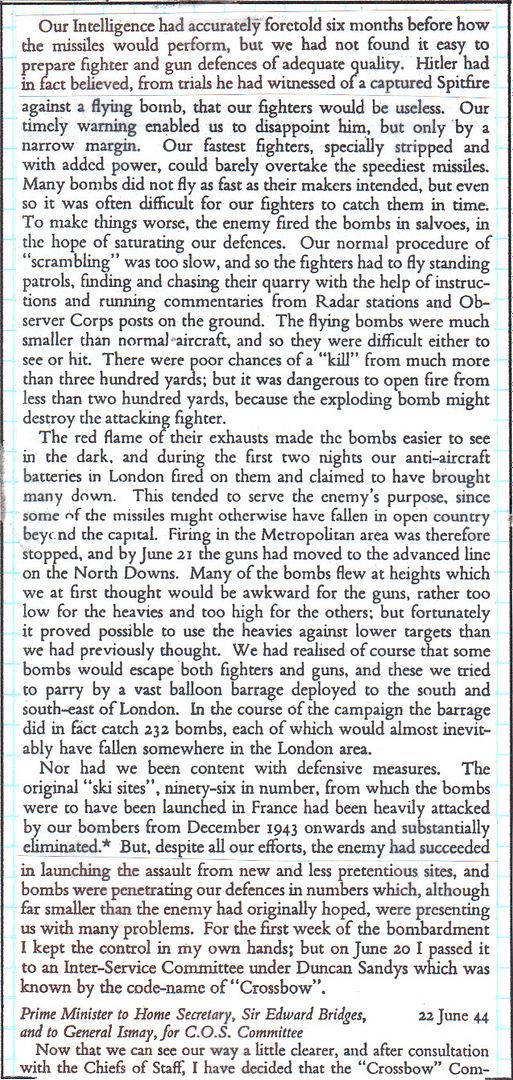
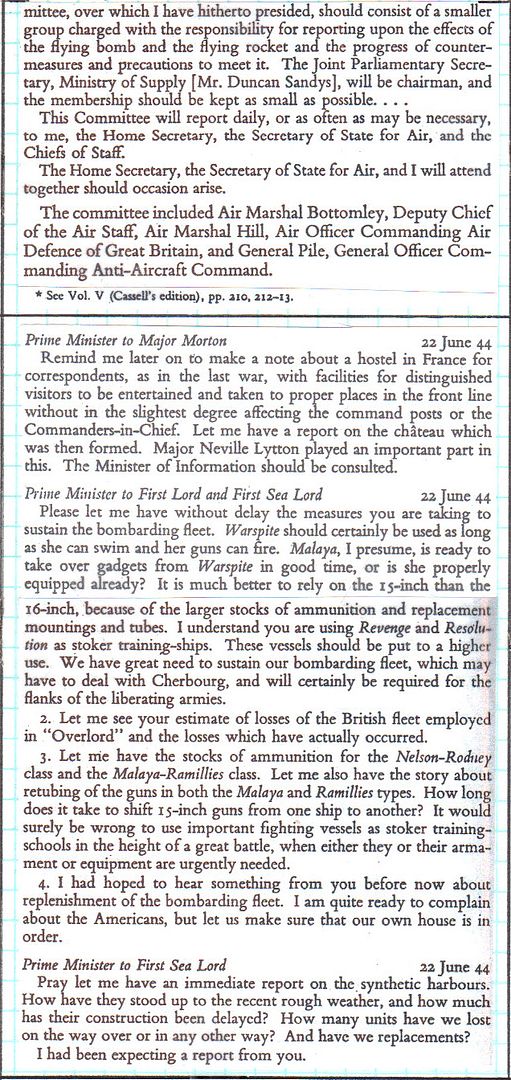
Winston S. Churchill, Triumph and Tragedy
http://www.onwar.com/chrono/1944/jun44/22jun44.htm#
Red Army launches Operation Bagration
Thursday, June 22, 1944 www.onwar.com
Red Army artillery lined up for the barrage [photo at link]
On the Eastern Front... During the night the Soviet summer offensive (Operation Bagration) opens with a massive artillery barrage and intensive bombing raids on rear areas of the German Army Group Center (Busch). This day marks the third anniversary of the invasion of the Soviet Union.
On the Western Front... After a preparatory air raid on Cherbourg, in which over 1000 tons of bombs are dropped, the divisions of the US 7th Corps (part of US 1st Army) begin assaulting the city of Cherbourg. There is heavy German resistance.
In the United States... President Roosevelt signs the “GI Bill” which introduces a range of benefits to be given to returned veterans.
In Occupied Denmark... Saboteurs damage a rifle manufacturing plant in Copenhagen.
In New Guinea... On Biak, American forces conduct a series of attacks which are believed to clear Japanese resistance in the west but experience renewed Japanese activity during the night. On the mainland, fighting continues near Aitape and Sarmi.
In the Mariana Islands... On Saipan, forces of the US 5th Amphibious Corps advance. The US 2nd Marine Division captures Mount Tipo Pole and fight for Mount Tapotchau. The US 4th Marine Division progresses east on the Kagman Peninsula.
In Burma... Elements of the British 2nd Indian Division link up with the 5th Indian Division at Milestone 107 on the Imphal-Kohima road. The siege of Imphal has been broken. Japanese forces experience heavy losses both due to combat and supply shortages.
http://www.etherit.co.uk/month/thismonth/22.htm
June 22nd, 1944 (THURSDAY)
UNITED KINGDOM: The Eighth Air Force in England flies four missions from England.
Mission 431: In a morning mission 85 B-17s and 132 B-24 Liberators attack 12 CROSSBOW (V-weapon) installations in the Pas de Calais area; one B-17 is lost. Escort is provided by 165 P-47 Thunderbolts and 97 P-51 Mustangs; some of the support fighters strafe coastal defenses; a P-51 is lost.
Mission 432: During the afternoon 797 bombers are dispatched to attack 22 targets in France and Belgium; nine bombers are lost:
1. Of 319 B-17s dispatched, 76 hit Lille/Fimes marshalling yard, 69 hit Ghent/Maritime marshalling yard, 35 hit Rouen oil depot, 13 hit La Vaubaliers, 13 hit Furnes Airfield, 13 hit Tingry, 12 hit Abbeville, 12 hit a tank area north of Rouen, 12 hit Douai railroad, 11 hit Mazingarbe, ten hit Pont a Vendin and one hits Douai railroad; three B-17s are lost. Escort is provided by 108 P-47s; they claim 1-0-0 Luftwaffe aircraft.
2. Of 149 B-24s, 46 hit Guyancourt/Caudron Airfield, 43 hit St Cyr Airfield, 36 hit Buc Airfield, 13 hit targets of opportunity and five hit Tours/La Riche bridge; they claim 1-0-0 Luftwaffe aircraft. Escort is provided by 187 P-38s and 36 P-47s; they claim 1-0-0 Luftwaffe aircraft; five P-38s are lost.
3. Of 216 B-17s, 70 hit Nucourt V-weapon site, 38 hit Brie-Comte-Robert Sug, 33 hit Etampes Airfield, 11 hit Lieusant railroad, 11 hit Melun bridge and 11 hit Melun marshalling yard; they claim 1-0-0 Luftwaffe aircraft; four B-17s are lost. Of 113 B-24s, 101 hit an oil dump at Paris and one hits Dreux Airfield; two B-24s are lost. Escort is provided by 78 P-51s; three P-51s are lost.
4. Nine B-24s use Azon glide bombs against the Samur Bridge; escort is provided by 41 P-51s.
Mission 433: A B-17 flies a daylight leaflet mission to La Glacrie, France.
Mission 434: Nine B-17s drop leaflets in France and the Low Countries during the night.
Ten B-24s fly CARPETBAGGER missions in France during the night.
Personal Memory: Today we are again doing tactical (No Ball) targets trying to slow the Buzz Bomb attacks. My diary for this date reads: “St. Omar, France, (Calais Area) robot plane installations. Flew low squadron lead. Flak meager but VERY accurate. Lost two ships, one was leader. three tenths CAVU. Only 14 went out. Rough!”I have no idea why we were carrying two, two thousand pound bombs for such a small target. Perhaps it was a mission changed from a bridge busting sortie. My own idea would have been to carry a bunch of smaller bombs. Of course I had no say in the matter and anyhow all we did was dig ponds for some farmer. My diary was wrong about the loss of two B-17s that morning as only one didn’t return. That was our leader 1st Lt. R.W. Erickson who had Capt. R.J. Lynch flying as mission commander in his plane named “Mary Cary.” Deputy lead was also hit by flak but managed to get to Grafton Underwood for an emergency landing. The original lead plane was last seen headed for the English coast at Beachy head but they never made it after the runaway number two engine exploded.The crew was ordered to bail out but the plane exploded before they all got out and half were killed. The other half were rescued by naval vessels. Score: Milk runs 13, others: 7 Afternoon mission: This afternoon we are loaded with twelve 500 pound bombs to try to bust a railroad yard at Lille, France. Beiser and I were assigned position 8 which made us the leader of a three-plane element. Our old “Buzz Blonde” that was severely damaged at Hamburg a few days ago was trying to fly this mission but had to abort because it couldn’t keep up. Just after bombs away the airplane in the eleventh position was hit by flak in the right wing just behind the number 3 engine causing a gasoline explosion. Only the radio operator, Tech. Sgt R. H. Johnson survived. He was able to evade capture and return to American control. All the rest of the crew died in the explosion. Score:
Milk runs 13, Others 8 (Dick Johnson)
Rescue tug HMS Enigma launched.
Light cruiser HMS Swiftsure commissioned.
FRANCE: A two hour air raid begins the final battle for Cherbourg in which 1,000 tons of bombs are dropped. The divisions of VII Corps then attack and meet fierce resistance.
Gnr Elmer Schauer of the 78th Battery, Canadian Army, showed particular Courage while in the OP (Observation Post) at Putot-en Bessin as a signaller. The OP was established in a slit trench on an exposed flank of the Company Area with the tank parked about 50 yards to the rear. The Company position came under heavy mortar and artillery fire during which time the enemy attacked and succeeded in infiltrating in and around the position. As the OP was in as exposed position, the enemy subjected it to heavy machine gun fire. Gnr. Schauer saw the predicament and on his own initiative climbed up on the tank and into the turret. With the help of Gnr’s Braham and Toy brought down direct fire with the 75mm gun of the tank onto the enemy, succeeding in completely neutralizing the enemy fire from this sector. He then provided further covering fire for the OP Officer, who was able to direct artillery fire on other enemy troops.
For this action Gnr. Elmer Schauer was awarded the Croix-de-Guerre. (Daniel Ross)(Link)
Around 600 B-26 Marauders and A-20 Havocs and 1,200+ fighters of the USAAF’s Ninth Air Force fly missions during the day; the main effort consists of an attack on the tip of the Cherbourg Peninsula in support of the US VII Corps assault on the port of Cherbourg; beginning one hour before the ground attack and continuing until the attack begins fighters and fighter-bombers pound the whole area south of the city from low level; as the ground assault begins, B-26s and A-20s strike a series of strongpoints selected by the US First Army, forming a 55-minute aerial barrage moving north in advance of ground forces; later in the day B-26s attack marshalling yards, fuel dumps and a German headquarters; fighter-bombers fly armed reconnaissance over various railroads and bomb rail facilities, trains, road traffic and gun emplacements; 25 fighter-bombers are lost during the day’s operations.
GERMANY: U-1064 launched.
DENMARK: Saboteurs of the Danish Resistance wreck a rifle manufacturing plant in Copenhagen.
FINLAND: German Foreign Minister Joachim von Ribbentrop”>Ribbentrop arrives in Finland to negotiate about military aid to be given Finns to keep them in the war. The Red Army renews its offensive west of Viipuri. Soviet forces try to cross the narrow straits just west of the center of the city but are repelled by Finnish artillery fire. Maj. Gen. Alonzo Sundman’s 17th Division relieves Col. Kai Savonjousi’s 10th Division west of Viipuri.
POLAND: Chelm: The USSR sets up a puppet “Polish Committee for National Liberation.”
U.S.S.R.: The Red Army has chosen today, the third anniversary of the German invasion, to launch a massive assault on the Nazi forces occupying Byelorussia. It is called Operation Bagration, after the Czarist general who was mortally wounded fighting Napoleon at Boridino in 1812, and its object is nothing less than to destroy Hitler’s Army Group Centre.
Last night, partisans blew up railway lines, bridges and telephone cables in 10,500 separate places, effectively severing the Germans’ supply and communications lines. Then the huge weight of the Red Army crashed into the German defences. The Russians have assembled nearly 1.2 million men in 124 divisions, 5,200 tanks and assault guns, and 6,000 aircraft to smash a German force of 400,000 men supported by just 900 tanks and heavy guns and 1,300 aircraft.
German intelligence reports had given General von Busch, the commander of Army Group Centre, clear warning of the Russian buildup, but Hitler, relying on his “intuition”, has been deceived by a Russian maskirova (disinformation) operation into believing that the Red Army was planning a double thrust in the south to the Romanian oilfields and Warsaw He was so sure that he had outguessed the Russians that he sent 48 infantry divisions and three Panzer divisions to Galicia, leaving von Busch’s forces dangerously thin on the ground. The man and tanks he switched to the south have now been bypassed and are playing no part in the battle.
Hitler’s mistake became apparent at 5am today when the Red Army opened up with its customary overwhelming barrage from guns which were virtually wheel to wheel along the front. When the barrage lifted, hordes of T-34tanks scurried towards the German defences, each followed by a tight group of infantry. Sturmoviks lurked overhead to pounce on strongpoints. The speed and punching power of the assault soon tore gaping holes in the attenuated German lines.
The Russians are racing west through these gaps, heading for Minsk. General Bagramyan’s First Baltic Front has made a double breakthrough against General Reinhardt’s 3rd Panzer Army to isolate Vitebsk, and some 30,000 Germans are in danger of being surrounded. As the hammer blows descend the whole German position in Byelorussia is under threat.
Poltava: The Luftwaffe made a devastating attack on this Ukrainian airfield last night, killing 26 crewmen of the US Eighth Army Air Force, and destroying 47 and severely damaging 26 Flying Fortresses, which have landed here after attacking a German synthetic oil plant. They had flown on to Poltava, one of three airfields made available by the Russians. But they had been shadowed by a German plane, and later 75 He-111s and Ju88s attacked. A fuel dump containing over two million litres of fuel exploded and the aircraft burst into flames.
Because of the attack on USAAF Eighth Air Force B-17s at Poltava, USSR, on yesterday’s shuttle mission, the B-17s at Mirgorod and P-51s at Piryatin are moved farther east; they are to be returned to Mirgorod and Piryatin to be dispatched to bases in Italy as soon as the weather permits; the move is fortunate as German bombers strike both Piryatin and Mirgorod during the night of 22/23 June.
ITALY: Following 5 consecutive days of bad weather, the USAAF’s Fifteenth Air Force in Italy dispatches 600+ B-17s and B-24s to bomb targets in northern Italy; B-17s hit marshalling yards at Fornova di Taro, Modena and Parma; B-24s hit six marshalling yards and two bridges in Italy, an automobile factory at Turin and an automobile depot at Chivasso; fighters fly 250+ sorties in support of the missions.
INDIA: The siege of Imphal is raised as advance units of the British 2nd Indian Division link with the British 5th Indian Division at mile 107 of the Imphal-Kohima road.
The Japanese Fifteenth Army which invaded India in Operation U-Go has failed. Of the 100,000 Japanese who marched from Burma, 30,502 are dead and 23,003 wounded, at a total loss to the Allies of 2,700 killed and 10,000 wounded.
Imphal was under siege for three months. General Renya Mutaguchi sent three divisions of the Fifteenth Army against the Allies: the 33rd drove north from Tiddim, and the 15th and 31st attacked the Allied bases at Imphal and Kohima from the east. Against this the Allies mustered four Indian divisions under Lt-Gen Geoffrey Scoones. The 17th and 20th held the Imphal perimeter, and the 5th and 23rd hunted out the overstretched Japanese on the Imphal plain, hammering them against Imphal’s anvil.
Allied control of the Imphal plain and the skies above it was backed by secure communications. Imphal has been supplied by air since April. Mutaguchi, however, refused to admit defeat at Imphal or Kohima, ignoring the realities of the field.
Lt-Gen Kotoku Sato withdrew his 31st Division from Kohima on 3 June with no prospect of supply, it ran out of ammunition and food rations; he had refused Mutaguchi’s demand to regroup and attack Imphal without even finding food. Sato’s withdrawal freed two more Allied divisions for Imphal.
Mutaguchi has been ordering the 15th Division to mount ever more ambitious operations, simultaneously stripping its commander Lt-Gen Masafumi Yamauchi, of manpower until today he commands a mere battalion and a half. No wonder Yamauchi has spent much of his time writing despairing haiku poetry.
The fighting has been close and bloody, with the besieging Japanese crawling over their dead to reach the trenches surrounding Imphal. Outside, the battle swayed to and fro, the highest casualties on both sides suffered on the Ukhrul road and the Shenam Saddle. Conditions are appalling: heavy rain, mist and thick jungle have made transport and observations difficult. The Imphal to Kohima road itself is a single track overlooked by high ridges from which the Japanese launched a series of deadly attacks and stubborn defences.
The turning-point in the battle came on 17 June, when the Japanese abandoned Mao Songsan ridge, the first time that they had given up a position without a fight in the entire campaign.
NEW GUINEA: The fighting for the island of Biak Guinea is essentially finished after the US attacks today.
MARIANAS ISLANDS, SAIPAN: The 2nd Marines take Mount Tipo Pale and move on to Mount Tapotchau. The 4th Marines are fighting east on the Kagman Peninsula.
USS NATOMA BAY launches 25 P-47 Thunderbolts for delivery to Saipan.
CANADA: Frigate HMCS Prestonian launched Lauzon, Province of Quebec.
Minesweeper HMS Seabear commissioned.
U.S.A.: Washington: US President Roosevelt”>Roosevelt signs the “GI Bill”. This will give a range of various benefits to returning veterans. Education and home loans are among the benefits included.
CINCPAC COMMUNIQUÉ NO. 59, 1. During the attack by enemy carrier-type aircraft on our ships on June 18 (West Longitude Date), 353 enemy aircraft were shot down of which 335 were destroyed by our carrier aircraft and 18 by our own antiaircraft fire. This is a revision of the estimate contained in communiqué No. 56.
Two of our carriers and one of our battleships received superficial damage. We lost 21 aircraft in combat.
2. The following information is now available concerning the attack of our carrier aircraft upon units of the Japanese fleet in the late afternoon of June 19 (West Longitude Date).
The enemy forces attacked consisted of: Four or more battleships, five or six carriers, five fleet tankers, and attached cruisers and destroyers.
On the basis of information presently available, our planes inflicted the following damage One carrier, believed to be the Zuikaku, received three 1,000-pound bomb hits. One Hayataka Class carrier was sunk. One Hayataka Class carrier was severely damaged and left burning furiously. One light carrier of the Zuiho or Taiho Class received at least one bomb hit. One Kongo Class battleship was damaged. One cruiser was damaged. Three destroyers were damaged, one of which is believed to have sunk. Three tankers were sunk. Two tankers were severely damaged and left burning. Fifteen to 20 defending aircraft were shot down.
Our losses were 49 aircraft, including many which landed in the water at night and from which an as yet undetermined number of pilots and aircrewmen have been rescued. Search for others is continuing.
3. The engagement was broken off by the Japanese fleet which fled during the night toward the channel between Formosa and Luzon The Pacific Fleet units in these two actions were commanded by Admiral R. A: Spruance. The carrier task force was under the immediate tactical command of Vice Admiral M. A. Mitscher.
CINCPAC COMMUNIQUÉ NO. 60, Our troops on Saipan Island have made further advances of more than a mile along the shoreline of Magicienne Bay to the town of Laulau and have advanced about a mile up Mount Tapotchau. The pocket of enemy resistance tat Nafutan Point has been reduced by one half, and our forces have gained the heights of Mount Nafutan on the east coast. Heavy pressure is being maintained night and day against enemy troop concentrations and defence works by our aircraft, Army and Marine artillery, and Naval gunfire.
At night on June 20 (West Longitude Date) several enemy aircraft dropped bombs near our transports and along shore but did no damage.
Sporadic fire has been directed against our ships by shore batteries but the enemy emplacements have been quickly knocked out.
JUNE 22, 1944 STATEMENT BY SECRETARY OF THE NAVY JAMES FORRESTAL
“Under the circumstances our Fleet did a magnificent job, but the Navy is not going to be satisfied until the Japanese Fleet is wiped out.
“The Japanese were extremely cautious and never came very far to the eastward so that the bulk of our forces could engage them. As a result, we were able to send home but one air attack at very long range from our carriers just before dark.
“Some of the Japanese vessels which were damaged may be able to make port and eventually return to the fight. This is especially true of the war-ships, only one of which is reported as definitely sunk.” (Denis Peck)
The first Boeing B-17G-80-B0, with the Cheyenne Turret, is delivered.
Destroyer USS Haynsworth commissioned.
Submarine USS Dogfish laid down.
Minesweepers USS Facility and Execute launched.
In his third paragraph, Nimitz writes as if the Belleau Wood was lost.
". . . burning and listing from internal explosions as she passed him." Sort of like Ens. Gay at Midway.
Mission Number 3 for the Captain Charles E. Cook crew of the 493 Bomb Group. An aircraft is reported missing.
493d Bomb Group Mission 22 June 1944 – Etampes, France
8th Air Force Mission 432: During the afternoon 797 bombers are dispatched to attack 22 targets in France and Belgium; 9 bombers are lost:
Of 216 B-17s, 70 hit Nucourt V-weapon site, 38 hit Brie-Comte-Robert Sug, 33 hit Etampes Airfield, 11 hit Lieusant railroad, 11 hit Melun bridge and 11 hit Melun marshaling yard; they claim 1-0-0 Luftwaffe aircraft; 4 B-17s are lost, 1 damaged beyond repair and 187 damaged; 2 airmen are KIA and 30 MIA. Of 113 B-24s, 101 hit an oil dump at Paris and 1 hits Dreux Airfield; 2 B-24s are lost, 3 damaged beyond repair and 37 damaged; 1 airman is KIA, 2 WIA and 23 MIA. Escort is provided by 78 of 86 P-51s; 3 P-51s are lost (pilots are MIA).
Maps and mission strike photos can be found here:
493d Bomb Group Mission 11: The 493d Bomb Group supplied 33 aircraft for this mission, an attack on a railyard in France. Once again the Cook crew was the lead crew for the “B” Group, flying in a B-24J aircraft, serial number 44-40480. The command pilot on this mission was Lieutenant Colonel Henry Orban, one of the group’s squadron commanders. The normal tail gunner, SSG Walter H. Miller flew in the nose turret with the co-pilot back in the tail. Captain Donald B. Schulman from Group Headquarters was the extra navigator.
Take off from Debach was at 1445 and the group assembled at 19,000 feet. Assembly was accomplished visually after homing on a designated radio beacon, today this was one called Buncher 27. They crossed the French coast at 1750 reporting a normal run to the IP. The group made a run on the railway yard that was the primary target but spotted no rolling stock. A second run was made that confirmed no rolling stock, so the group was diverted to the secondary target, Mondesir Airfield in Etampes, France, southwest of Paris. “A” Group had shifted to the secondary target after one run on the railway yard leaving “B” Group several minutes behind on their run to Etampes. All 12 aircraft attacked and then assembled with the other groups of the wing for the return to England. The first aircraft landed back at Debach at 2122.
As the lead bombardier for “B” Group, First Lieutenant David Morris submitted a report on bombing upon his return. He noted that 404 bombs, all 100 lb general purpose were dropped on the the target. Several aircraft experienced rack malfunctions and were unable to release all of their bombs with one aircraft unable to drop any. These hung bombs were jettisoned over the channel on the return. Morris reported that the MPI was the center of the airfield with good results observed.
One aircraft failed to return from this mission, B24J 42-52759, piloted by Lieutenant William Kaplan was hit by flak, dropped out of the formation and were reported missing. They were on their fourth mission. Losing altitude and unable to make it back to England ordered the crew to parachute while he and the co-pilot, Lieutenant Kenneth Klemstine, remained with the aircraft until the last possible moment. They both jumped just before the aircraft crashed near the Chateau Chambord. A monument at the Chateau commemorates this event:
“On June 22, 1944, during World War II, an American heavy bomber, a B-24 “Liberator” from the U.S. Army 8th Air Force based in England, crashed here after bombing an airport southwest of Paris and being crippled by antiaircraft fire and German fighter planes. The aircraft’s pilot, Lt. William Kalan, had directed his crew to parachute earlier although he and co-pilot Lt. Kenneth Klemstine remained abord until shortly before the crash. At the time, priceless masterpieces from the Louvre Museum were hidden in the Château Chambord.”
“The two pilots were hidden separately by residents of the nearby villages of Huisseau-sur-Cosson and Montlivault for several months – during which time Lt. Kalan took part in Allied arms drops and other Resistance engagements – before both pilots crossed the Loire to join approaching U.S. troops.”
http://en.tracesofwar.com/article/7758/Information-Panel-Crashed-B-24-at-Ch%E2teau-Chambord.htm
I fugured that's what he must have meant. The Belleau Wood won't be hit for a few more months.
“Poltava: The Luftwaffe made a devastating attack on this Ukrainian airfield last night, killing 26 crewmen of the US Eighth Army Air Force, and destroying 47 and severely damaging 26 Flying Fortresses, which have landed here after attacking a German synthetic oil plant. They had flown on to Poltava, one of three airfields made available by the Russians. But they had been shadowed by a German plane, and later 75 He-111s and Ju88s attacked. A fuel dump containing over two million litres of fuel exploded and the aircraft burst into flames.”
Hmmm...bit of a failure of US/USSR prevent defense there...
1. Failure to prevent/detect shadowing
2. Failure to prevent/detect incoming bombers
Uh-oh, Wiki page shows Soviets were really incompetent in the air defense of that field:
http://en.wikipedia.org/wiki/Poltava_Airfield
Spirited celebrations at Poltava during FRANTIC-1 marked the high point of U.S.-Soviet air cooperation. FRANTIC-2, which arrived from England late on 21 June, triggered equal euphoria that ended abruptly with air raid warnings beginning around midnight. Personnel retreated to new slit trenches distant from the aircraft parking area. For this reason, U.S. personnel losses were limited to two killed and several wounded in the subsequent German air attack.[6]
About eighty German aircraft combined in one of history’s most effective bombing raids, lasting over two hours. He-111s began with level bombardment, followed by low-altitude strafing by Ju-88s. He-177s provided before-and-after reconnaissance.[7] According to the internal history: “43 Fortresses were destroyed or damaged beyond repair; 3 C-47s and 1 F-5 were likewise destroyed. 26 Fortresses, 2 C-47s and 1 C-46, and 25 Russian aircraft (mainly Yak fighters) were heavily damaged but repairable; over 450,000 gallons of gasoline were destroyed and over 500 gallons of aircraft oil; over 3200 bombs, 26,000 bomb fuses, and 1,360,000 cartridges were destroyed.”[8]
25 Russians were killed on the night of the raid, but anti-personnel bomblets continued to go off for weeks after the attack, causing continuing casualties.[9]
Flyable aircraft from all three bases were evacuated next morning to Soviet air bases farther east. The other two bases were attacked the next nights. Surviving bombers consolidated into one group and flew home several days later.
The disaster infuriated many Americans because Soviet air defenses were completely ineffective. The head of the Military Mission in Moscow, General John Deane reported back: “The Russian anti-aircraft and fighter defenses failed miserably. Their anti-aircraft batteries fired 28,000 rounds of medium and heavy shells, assisted by searchlights, without bringing down a single German plane. There were supposed to be 40 Yaks on hand as night fighters, but only four or five of them got off the ground. Both their anti-aircraft and night fighters lacked the radar devices which made ours so effective.” (If nothing else, the statements by a ranking American that “the Russian...anti-aircraft batteries fired 28,000 rounds of medium and heavy shells...” and that “...only four or five (Yaks) got off the ground” completely refutes certain other claims that the Russians provided nothing more than a single truck carrying .50 caliber machine guns as air defense.) Although no such claim is made concerning “one truck” carrying .50 caliber machine guns, it is likely General Deane was referring to the 28,000 rounds fired being a combination of mostly heavy .50 caliber shells along with some medium Yak fired shells. The point being that the Russian defenses could not hit the broad side of a barn, or were not trying to actually shoot down the attacking Luftwaffe planes during the three hour attack. Five Yaks taking to the air constituted a small fraction of what could have been put into the air to counter the Luftwaffe attack. For all intents and purposes, the only defenses provided by Stalin were indeed American made .50 caliber machine guns mounted on American made trucks.
American fighters were not permitted to take off (U.S. air operations were governed by a cumbersome 24-hour long permitting process), but without radar they would have been equally ineffective.[10] Radar would not have been required to track and locate the attacking Luftwaffe planes. Everyone knew where they were coming from and what their target was. Hansen is a counterproductive and unreliable source. The main point is that Stalin would not allow any effective defenses during the attack by the Luftwaffe. In the preceding paragraph General Deane stated the Yaks had no radar available like our night fighters there did.
Afterwards the USAAF discontinued heavy bomber operations at Poltava for about a month. FRANTIC-3 and 4 consisted of long-range fighters. The Americans also insisted on stationing radar-equipped night fighters, P-61s of the 427th Night Fighter Squadron, at Poltava, but Soviet permission could not be obtained.[11]
Emotion overriding common sense? .50 caliber aren't heavy anti-aircraft shells. Soviet anti-aircraft. Available anti-aircraft weapons would have included 25mm, 37mm, 75mm, and 85mm (the latter two would certainly be considered heavy caliber, the 25 and 37 mm perhaps medium. Light would have been the 12.7mm and perhaps 7.62.
Chambord is one of the most beautiful chateaus in France. Good thing they missed it.
The problem was it depended on Soviet cooperation and air defense, neither of which were they inclined to extend. As the British experience in the Arctic ports showed, Stalin was paranoid about insulating his people from contact with the Western allies so they would not see how free and prosperous we were and how much better equipped we were. Thus, the severe restrictions imposed on us.
Besides this disastrous air raid, the other event that will make a big impression on our personnel will be during the Warsaw uprising, the Sov's absolutely forbade the Air Force from dropping any aid or taking any action in support.
I suppose the good that the experience produced was that many Air Force officers ended the War with no illusions about the reality of communist rule, unlike many in the Roosevelt administration.
Chambord is also south of their target. I wonder if they had trouble controlling the airplane, or were they headed for Switzerland?
Good question. Blois is still closer to the Channel than Switzerland.
The documents that I have for this mission did not include the routing map (so of the missions include that). That would show the assigned heading when they came off the target.
Disclaimer: Opinions posted on Free Republic are those of the individual posters and do not necessarily represent the opinion of Free Republic or its management. All materials posted herein are protected by copyright law and the exemption for fair use of copyrighted works.